Nuummite is a rare and unique metamorphic rock that is prized for its distinctive iridescent play of colors. It is primarily composed of two minerals: anthophyllite and gedrite, both of which belong to the amphibole group. Nuummite is known for its deep, lustrous hues, which can include shades of blue, green, gold, and sometimes even red or violet.
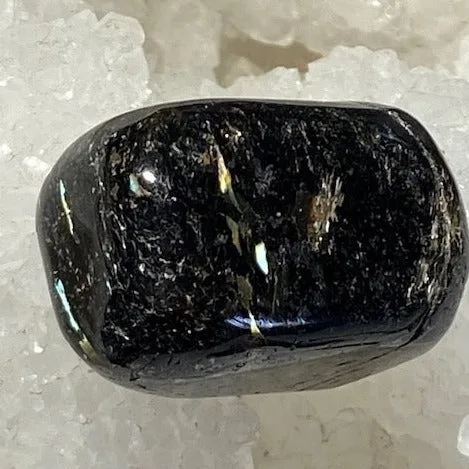
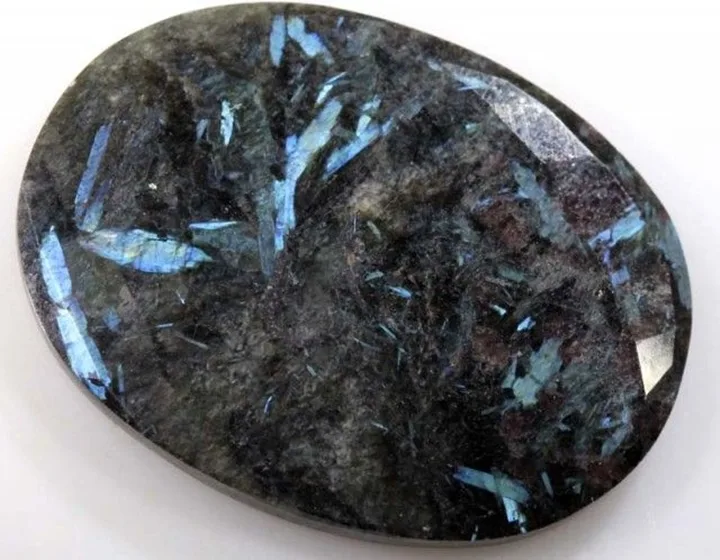
Origin: Nuummite is found in only a few locations worldwide. The primary source is the Nuummite deposits in the Precambrian rocks of the Nuuk region in Greenland. Other deposits have been identified in Canada and the United States, but the Greenlandic material is the most sought after.
Appearance: What sets Nuummite apart is its chatoyancy, or the ability to display a cat’s-eye effect. This effect is caused by the presence of reflective minerals oriented in parallel layers within the rock. The play of colors is often reminiscent of the Northern Lights, adding to its allure.
Metaphysical Properties: In the realm of metaphysics and crystal healing, Nuummite is believed to possess spiritual and grounding properties. It is associated with inner power, intuition, and self-discovery. Some people use Nuummite for meditation and to enhance psychic abilities.
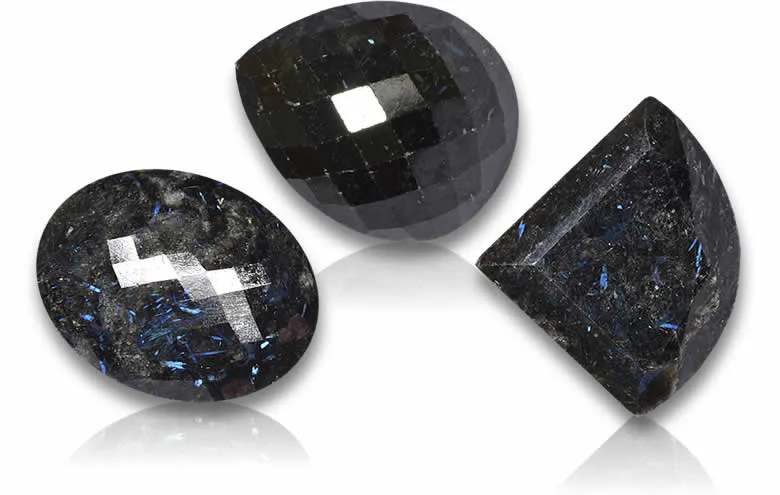
Uses: Nuummite is commonly used in the creation of ornamental and lapidary items, including cabochons, beads, and carvings. It is also occasionally used in jewelry, although its relative softness compared to other gemstones requires careful handling to avoid scratches.
Due to its limited availability and unique aesthetic qualities, Nuummite is often considered a collector’s item and is valued for its rarity and beauty. Keep in mind that while some people ascribe metaphysical properties to Nuummite, these beliefs are not scientifically proven, and the stone is primarily appreciated for its geological and aesthetic attributes.
Physical Properties of Nuummite
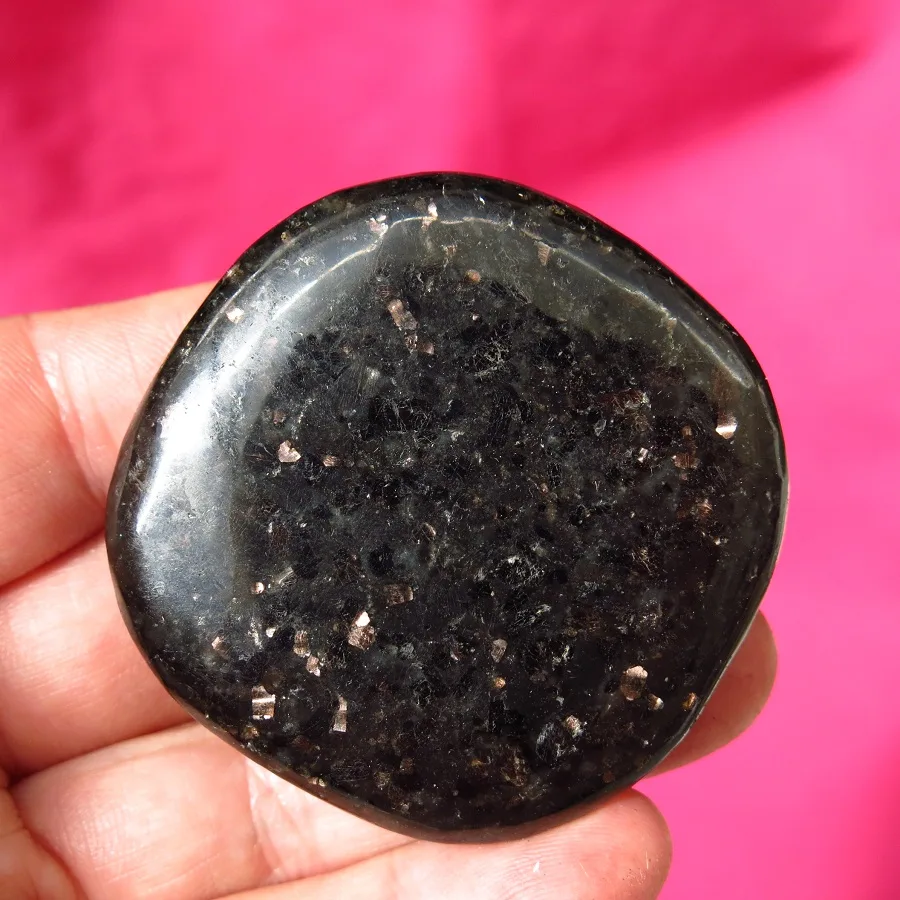
Nuummite, being a metamorphic rock composed mainly of amphibole minerals, exhibits certain physical properties that contribute to its unique characteristics. Here are some of the key physical properties of Nuummite:
- Hardness: Nuummite has a variable hardness ranging between 5 and 6 on the Mohs scale. This puts it in the mid-range of hardness, making it susceptible to scratches and wear over time. It is softer than many popular gemstones, so care is needed to prevent damage.
- Color: Nuummite is known for its striking iridescence and can display a wide range of colors. The most common colors include shades of brown, black, gold, green, and blue. The iridescence is often in the form of a chatoyant or cat’s-eye effect, especially when the stone is polished.
- Luster: The luster of Nuummite is generally vitreous to slightly resinous. When polished, the surface can exhibit a shiny or glassy appearance.
- Transparency: Nuummite is typically opaque, meaning that light does not pass through the stone. The play of colors and chatoyancy is observed on the surface of the stone rather than through it.
- Density: The density of Nuummite varies, but it is generally denser than average rocks due to the presence of heavy minerals like anthophyllite and gedrite.
- Cleavage: Nuummite exhibits good cleavage in two directions due to its mineral composition. Cleavage refers to the tendency of a mineral to break along specific planes.
- Structure: Nuummite is a metamorphic rock with a foliated structure, meaning it has a layered or banded appearance. The layers are often a result of the alignment of mineral grains during the rock’s formation under high-pressure metamorphic conditions.
Understanding these physical properties is crucial for lapidaries, jewelers, and collectors who work with or appreciate Nuummite. It helps in the proper identification, handling, and appreciation of the stone’s unique characteristics.
Chemical Composition of Nuummite
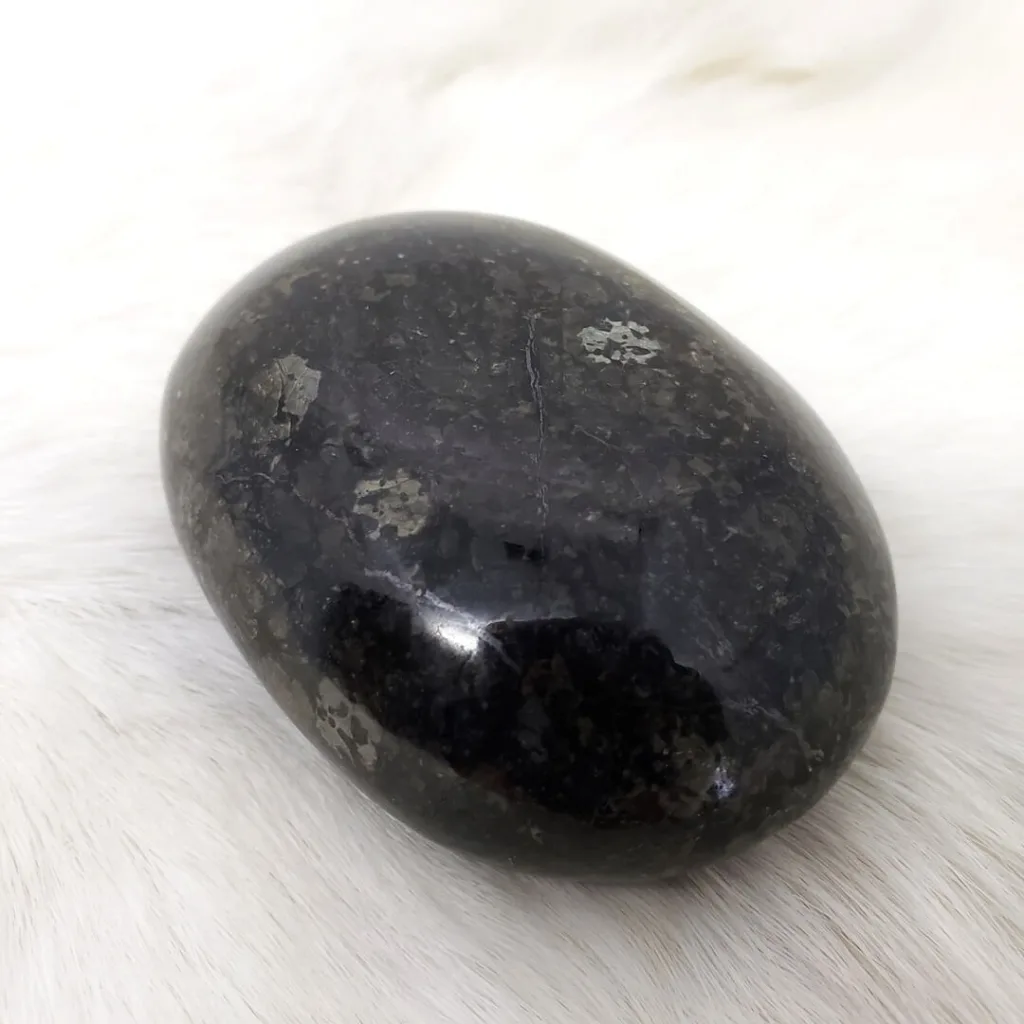
Nuummite is a metamorphic rock composed mainly of two amphibole minerals: anthophyllite and gedrite. The chemical composition of these minerals contributes to the overall composition of Nuummite. Here are the general chemical formulas for anthophyllite and gedrite:
- Anthophyllite: (Mg,Fe)7Si8O22(OH)2
- Anthophyllite is a member of the amphibole group and is rich in magnesium and iron. The variable composition is indicated by “(Mg,Fe),” meaning that magnesium and iron ions can substitute for each other in the mineral structure.
- Gedrite: (Mg,Fe)2Al3(Si,Al)4O11(OH)2
- Gedrite is another amphibole mineral with a complex formula. Similar to anthophyllite, it contains variable amounts of magnesium and iron. It also includes aluminum in its structure, with a variable amount of silicon.
Nuummite may also contain other minerals or accessory components depending on its specific geological origin. The combination of anthophyllite and gedrite, along with any additional minerals, gives Nuummite its unique appearance and properties.
It’s important to note that Nuummite is not a single mineral but a rock composed of several minerals. As such, its chemical composition can vary somewhat depending on the specific geological conditions of its formation. Analyzing the chemical composition provides insights into the mineralogical makeup of the rock and helps in understanding its properties and classification within the broader category of metamorphic rocks.
Geological Formation
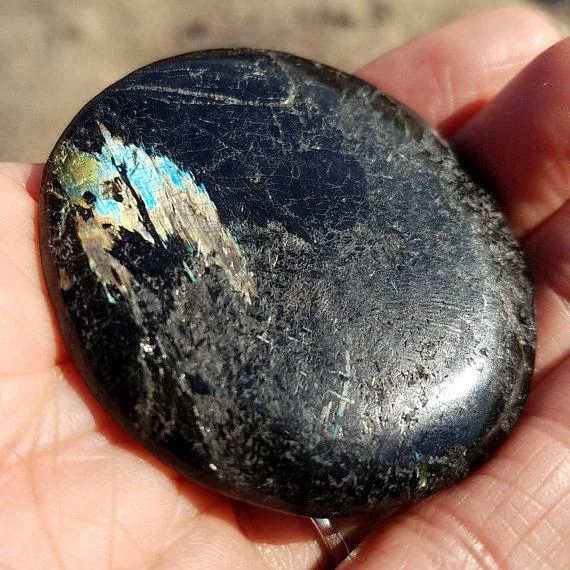
Nuummite is a metamorphic rock, and its formation is intricately linked to geological processes that involve high pressure and temperature. Here’s an overview of the geological formation of Nuummite:
- Parent Rock: The precursor or parent rock of Nuummite is believed to be peridotite, a type of ultramafic rock rich in olivine and pyroxene. Peridotite is typically found in the Earth’s mantle.
- Metamorphism: Nuummite forms through a metamorphic process called amphibolite facies metamorphism. This type of metamorphism occurs under high pressure and temperature conditions, usually within the Earth’s crust. The metamorphic grade is characterized by the presence of specific mineral assemblages, including amphiboles like anthophyllite and gedrite.
- Tectonic Activity: The geological conditions required for the formation of Nuummite are associated with tectonic activity. This can include processes like subduction zones, where one tectonic plate is forced beneath another, leading to increased pressure and temperature in the Earth’s crust.
- Regional Metamorphism: Nuummite is often associated with regional metamorphism, where large areas of rock are subjected to intense pressure and heat. This can occur during mountain-building events or other tectonic processes that cause significant changes in the Earth’s crust.
- Mineral Transformation: During the metamorphic process, the minerals in the parent rock, peridotite, undergo significant changes. The amphibole minerals anthophyllite and gedrite, along with potentially other minerals, crystallize and align themselves in distinct layers or bands, contributing to the characteristic foliated appearance of Nuummite.
- Iridescence Formation: The iridescence observed in Nuummite is a result of light interacting with microscopic platelets of varying compositions within the rock. This interaction produces the chatoyancy or cat’s-eye effect.
Nuummite’s unique geological history, combined with the specific mineralogical composition resulting from metamorphism, contributes to its rarity and aesthetic appeal. The geological processes involved in its formation provide valuable insights into the Earth’s dynamic processes over time. The primary source of high-quality Nuummite is the Nuuk region in Greenland, where these geological conditions have led to the development of this extraordinary metamorphic rock.
Historical and Cultural Significance
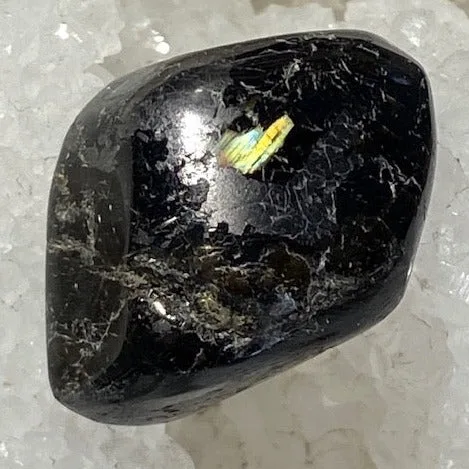
Nuummite holds historical and cultural significance, particularly in the context of the indigenous people of Greenland and their connection to the land. Here are some aspects of its historical and cultural importance:
- Inuit Culture: Greenland, where Nuummite is primarily found, is home to the Inuit people. Nuummite has been used by the Inuit for centuries, both for practical purposes and spiritual beliefs. The stone is often considered sacred and is believed to possess protective and healing properties.
- Spiritual and Metaphysical Beliefs: In various spiritual and metaphysical traditions, Nuummite is associated with deep grounding, inner power, and spiritual growth. Some believe that it can help in accessing ancient wisdom, connecting with one’s intuition, and providing protection during spiritual journeys. These beliefs contribute to the stone’s popularity in the world of crystals and alternative healing practices.
- Art and Artifacts: Nuummite has been used by the Inuit people to create tools, weapons, and artistic carvings. The stone’s unique appearance, with its play of colors and chatoyancy, makes it a desirable material for creating aesthetically pleasing objects. Artifacts made from Nuummite may also hold cultural and symbolic meanings within the Inuit community.
- Connection to the Land: The geological rarity of Nuummite and its association with specific regions, especially the Nuuk area in Greenland, underscores its connection to the land. The stone’s presence and use in cultural practices highlight the significance of geological resources in shaping local traditions and lifestyles.
- Collectors and Jewelry: Beyond its cultural significance, Nuummite has gained attention among collectors and those interested in unique gemstones and minerals. The stone is sometimes used in jewelry, and its rarity makes it a sought-after material for those looking for distinctive and meaningful pieces.
- Greenlandic Identity: Nuummite contributes to the cultural identity of Greenland, serving as a tangible representation of the region’s geological wealth. Its inclusion in art, crafts, and cultural practices helps reinforce a sense of connection to the land and the traditions of the Inuit people.
While Nuummite’s historical significance is deeply rooted in the traditions of the Inuit people and its geological rarity, its appeal has extended to a broader audience interested in crystals, gemstones, and unique artifacts with cultural and spiritual connections.
Uses of Nuummite
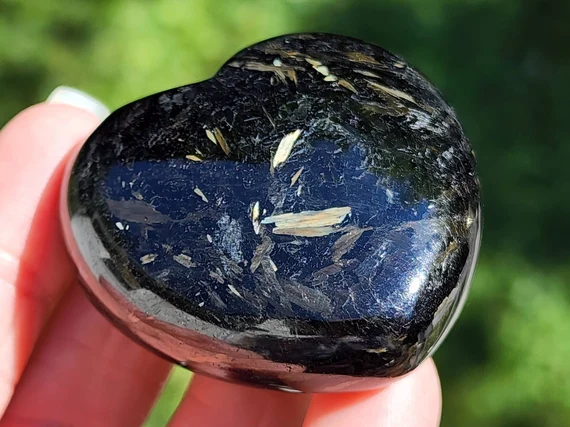
Nuummite has various uses, ranging from artistic and ornamental applications to spiritual and metaphysical purposes. Here are some common uses of Nuummite:
- Lapidary and Ornamental Objects: Nuummite’s unique appearance, with its iridescence and chatoyancy, makes it a popular choice for lapidaries and artisans. The stone is often cut and polished to create cabochons, beads, carvings, and other ornamental objects. These can be used in jewelry, sculptures, and decorative items.
- Jewelry: While Nuummite is not as hard as some other gemstones, it is still used in jewelry, especially in pieces that won’t be subjected to excessive wear. Nuummite cabochons, set in rings, pendants, earrings, and bracelets, can showcase the stone’s captivating colors and chatoyant effects.
- Collectibles: Due to its rarity and unique geological properties, Nuummite is often sought after by collectors of minerals, gemstones, and lapidary art. High-quality specimens or well-crafted pieces can become valuable collector’s items.
- Spiritual and Metaphysical Practices: Nuummite is believed by some to have spiritual and metaphysical properties. It is associated with grounding, protection, and intuition. Individuals interested in crystal healing and energy work may use Nuummite for meditation, balancing chakras, or enhancing psychic abilities.
- Art and Sculpture: Artists and sculptors may use Nuummite to create unique and visually striking pieces. The stone’s play of colors and chatoyancy can add a captivating dimension to sculptures and artistic installations.
- Cultural and Indigenous Artifacts: In regions where Nuummite is found, such as Greenland, the stone has historical and cultural significance. It has been used by indigenous people to create tools, weapons, and artifacts, as well as for artistic carvings that may have cultural or symbolic meanings.
- Symbolic Gifts: Nuummite, with its associations with grounding and protection, is sometimes given as a symbolic gift. It may be chosen for its metaphysical properties or as a meaningful and unique present for someone with an interest in gemstones and spiritual practices.
It’s important to note that while Nuummite is appreciated for its aesthetic and metaphysical qualities, individual experiences with the stone’s energy and impact may vary. As with any gemstone or mineral, personal beliefs and preferences play a significant role in its use and interpretation.




































